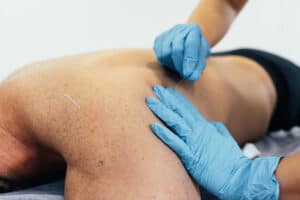Dry needling is a therapeutic technique in Australia that involves the insertion of very fine needles ( like acupuncture needles) into trigger points in the muscles or connective tissues, without injecting any substances. This technique is a form of natural therapy used to treat a variety of musculoskeletal conditions, including chronic pain, headaches, and sports injuries. This blog will explore the effectiveness of dry needling for pain relief, muscle and joint aches and stiffness and provide scientific evidence from Australian sources to support its use and answer some common questions about this technique.
What is Dry Needling?
Dry needling is a technique that is widely used in Australia to treat musculoskeletal conditions. Dry needling is a therapeutic technique that involves the insertion of fine needles into trigger points in the muscles or connective tissues, without injecting any substances. Trigger points are focal areas of muscle spasm that are tight and painful to the touch. These points can cause pain and discomfort, as well as refer pain to other parts of the body. Dry needling is also known as intramuscular stimulation, trigger point dry needling, or myofascial trigger point therapy.
The Effectiveness of Dry Needling for Pain Relief in Australia
Studies have shown that dry needling can be an effective form of treatment for pain relief. For example, a randomized controlled trial published in the Journal of Physiotherapy in 2015, looked at the effectiveness of dry needling for the treatment of chronic neck pain. The study found that dry needling was effective in reducing pain intensity and disability in patients with chronic neck pain.
Similarly, a systematic review and meta-analysis published in the Journal of Manual and Manipulative Therapy in 2018, looked at the effectiveness of dry needling for the treatment of knee osteoarthritis. The study found that dry needling was effective in reducing pain and improving physical function in patients with knee osteoarthritis. Another study published in the Australian Journal of Physiotherapy in 2013, looked at the effectiveness of dry needling for the treatment of plantar heel pain. The study found that dry needling was effective in reducing pain and improving function in patients with plantar heel pain.
FAQs about Dry Needling
Is dry needling painful?
Dry needling can be uncomfortable, but it is usually not very painful. The sensation is often described as a dull ache or a muscle cramp. Most people find the discomfort to be tolerable, and the benefits of the treatment usually outweigh the temporary discomfort.
Are there any risks or side effects of dry needling?
Dry needling is generally safe, but there are some risks and side effects to be aware of. The most common side effect is temporary soreness at the needle insertion site. Other potential side effects include bruising, bleeding, and infection. It is important to seek treatment from a qualified practitioner who is trained in dry needling to minimize the risk of complications.
How many sessions of dry needling will I need?
The number of sessions of dry needling required depends on the individual patient and their condition. Some patients may experience significant improvement after just one session, while others may require several sessions to achieve optimal results. Your practitioner will be able to provide a more accurate estimate of the number of sessions required after an initial assessment.
How long does the pain relief from dry needling last?
The duration of pain relief from dry needling varies from patient to patient. Some patients may experience long-lasting relief, while others may require regular maintenance treatments to manage their pain. The effects of dry needling can be cumulative, meaning that the benefits may increase with each session.
Can dry needling be used in combination with other treatments?
Dry needling can be used in combination with other treatments, such as chiropractic, physiotherapy, massage therapy, and exercise therapy. Your practitioner will be able to advise you on the best treatment plan for your specific condition.
Is dry needling covered by private health insurance in Australia?
Dry needling may be covered by some private health insurance policies in Australia. When dry needling is applied by a qualified and registered chiropractor or physiotherapist as part of their chiropractic or physiotherapy treatment, then it can be covered by health funds under chiropractic or physiotherapy treatment. The level of coverage and the specific conditions covered can vary depending on your policy. It is recommended to check with your insurance provider to confirm your level of coverage.
Is dry needling suitable for everyone?
Dry needling may not be suitable for everyone. Patients with certain medical conditions, such as bleeding disorders, pacemakers, or immune system disorders, may not be suitable candidates for dry needling. It is important to inform your practitioner of any medical conditions you may have before undergoing dry needling.
How do I find a qualified practitioner for dry needling?
It is important to seek treatment from a qualified practitioner who is trained in dry needling. In Australia, dry needling is typically performed by physiotherapists, chiropractors, and osteopaths who have undergone additional training in the technique. You can ask for recommendations from your healthcare provider or search online for practitioners in your area.
Dry Needling Practitioners at Active Back Care
There are independent chiropractors and physiotherapists who operate at Active Back Care who are trained in dry needling. They have undergone extensive training in the technique and along with careful daily use, they are skilled and proficient in the safe and effective application of dry needling. With their patient centered approach, they can develop personalized treatment plans that can incorporate dry needling where appropriate, to tailor the most effective care for the individual needs of their patients.
If you are experiencing pain or discomfort, consider an appointment with one of the experienced practitioners operating at Active Back Care. They are dedicated to helping you achieve optimal health and wellness. Each practitioner operates independently and takes individual responsibility for their own care and treatment.
Contact Active Back Care today to be connected with one of the independent Physiotherapists, Chiropractors or Massage Therapists operating there who can show you how dry needling can make a difference for your care. They can help you take charge of your health and recovery.
In conclusion, dry needling is a safe and effective technique for pain relief in patients with musculoskeletal conditions. Scientific evidence from Australian sources supports the use of dry needling for the treatment of chronic pain, headaches, and sports injuries. It is important to seek treatment from a qualified practitioner who is trained in dry needling to minimize the risk of complications. If you are considering dry needling as a treatment option, consult with your healthcare provider to determine if it is right for you.


Reader Interactions